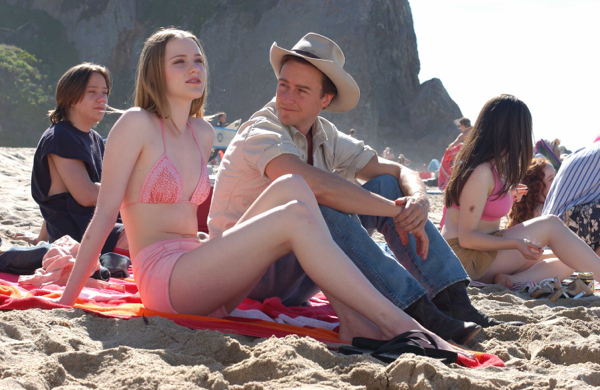Movie review by Greg Carlson
Reactions to writer-director David Jacobson’s “Down in the Valley” will be all over the map, given the movie’s ambitious intentions and its often frustrating disappointments. A weird love letter to the romance of the Old West, the film buries its allusions to classic Westerns like “Red River” in a plot that rehashes the familiar conflict of a psychotic outsider desperately trying to worm his way into a family. Channeling movies like James Foley’s “Fear,” “Down in the Valley” is visually striking but ultimately airless. The routine story simply cannot keep pace with Jacobson’s ruminations on the attraction of cinematic cowboy mythology.
Edward Norton, who was also one of the film’s producers, plays an “aw shucks” loner who goes by the name Harlan Caruthers. In his dusty Wranglers, his weathered cowboy hat, and his snap-button shirts, he moves, speaks, and acts like he belongs to another era entirely. Meeting up with a free-spirited teenager named Tobe (Evan Rachel Wood), the much older Harlan plunges headlong into an intense romantic relationship with the girl, much to the dismay and displeasure of Tobe’s hardworking corrections officer father Wade (the always impressive David Morse).
Given the substantial credentials of his cast, Jacobson is able to sustain – if only briefly – the notion that the strange, creepy Harlan would be able to get away with dating a girl roughly half his age. The red flags go up quickly, however, as Harlan runs afoul of the police when he “borrows” a horse from a cantankerous old man he claims is his pal. As Harlan’s ardor for Tobe intensifies, he even turns his attention to Tobe’s little brother Lonnie, teaching the boy how to fire a cherished single-action Colt .45 revolver.
Few critics will be able to resist pointing out the movie’s debt to ‘’Taxi Driver,” if only because the link is so obvious. Like “God’s lonely man” Travis Bickle, Harlan can be heard in voiceover writing letters to long lost loved ones and seen drawing his pistols in the mirror while he acts out his simmering rage. As the drama ramps up to an inevitable showdown, or series of showdowns, Jacobson piles on the Western accoutrements, even setting one of several climactic moments on an Old West movie-set main street, where the cameras are literally rolling.
Not all of Jacobson’s visual statements are quite as obvious. With the aid of Enrique Chediak’s widescreen cinematography, Jacobson manages to mournfully frame the contrasts of past and present. In one scene, Harlan maneuvers on horseback through houses under construction in a suburban development, underscoring Jacobson’s wistfulness for untamed, open spaces that have been paved over for some time. “Down in the Valley,” which refers to its San Fernando Valley setting, begins to drag at the halfway mark, and the film would have benefited from a bit more focus on Tobe. Additionally, some of the action in the final reel strains credulity, slipping in and out of melodrama – which just might be the ticket for viewers seeking yet another turn with one of American film’s most durable genres.
